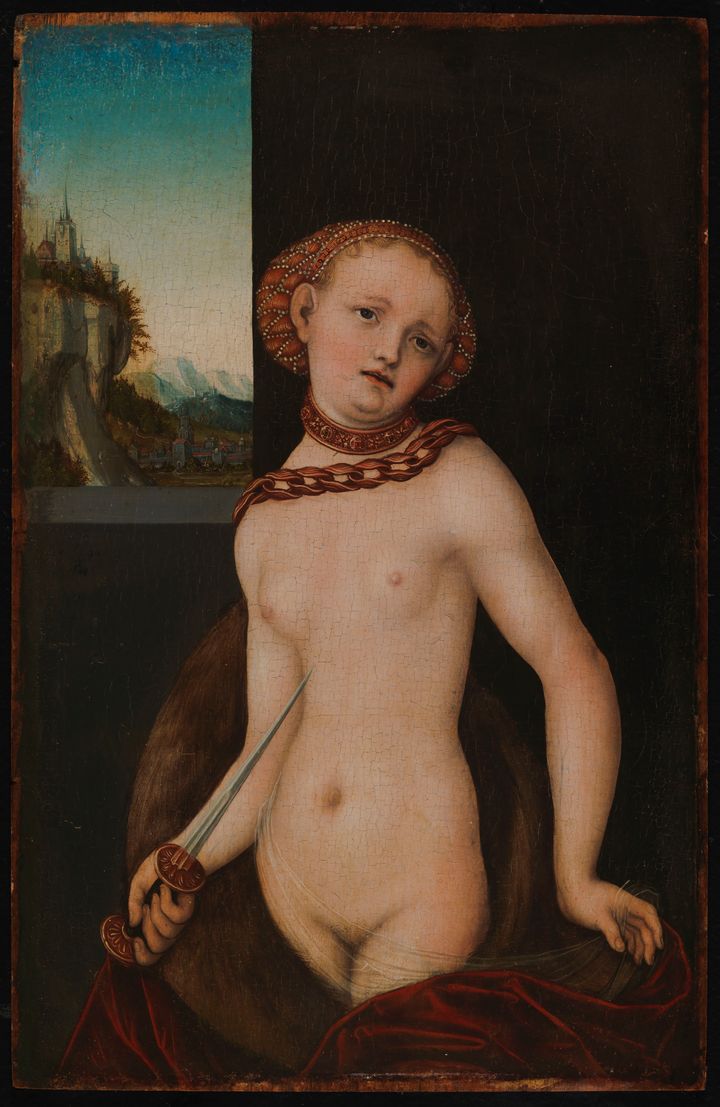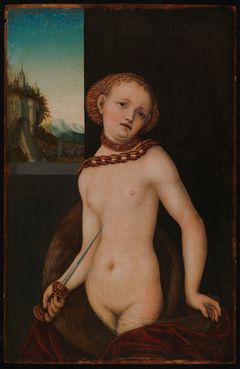Lucas Cranach - Renaissance Beauties 26.9.2019–5.1.2020

Cranach’s fascinating and enigmatic paintings have spoken to other artists over the ages. Among the best-known examples are probably the interpretations by Picasso, represented in the exhibition by some prints.
A present-day perspective on the handsome jewellery depicted in Cranach’s works is offered by a number of impressive items created by German jewellery artists.
The Artist
Lucas Cranach the Elder (1472−1553) is considered one of the most significant German Renaissance masters, and his paintings are cherished as great treasures by museums. He was a contemporary – and rival – of Albrecht Dürer (1471−1528). Above all, Cranach was a court painter. He worked in Wittenberg for the court of the Electors of Saxony, particularly Frederick the Wise (1486−1525), where he built his career.
Cranach can be justly described as a serial entrepreneur. He led a successful studio, where he worked with his sons Hans (who died young in 1537) and Lucas Cranach the Younger, who later took over the firm. Lucas Cranach’s studio was thus a family business, which was not uncommon during the Renaissance. He also owned an apothecary, which guaranteed him access to reasonably priced colours, as well as a printing press. Cranach also served as mayor of Wittenberg. Lucas Cranach and Martin Luther were close friends, serving as godfathers to each other’s children, for instance. Through his art, Cranach supported Luther in many ways related to the Reformation. Cranach is perhaps best known for his portraits of Luther and his wife Katharina von Bora.
It is estimated that Cranach’s studio produced thousands of works. More than 1,000 panel paintings are known at present. A catalogue of paintings is available at the Cranach Digital Archive website. Lucas Cranach the Elder’s output also includes drawings and copper etchings.
Ideals or identities?
The Sinebrychoff Art Museum’s exhibition Lucas Cranach - Renaissance Beauties presents an area of Cranach’s oeuvre that has received less attention: female beauty and nudes. The starting point for exhibition concept was the only Cranach paintings in Finland, which belong to the Sinebrychoff Art Museum collections: Portrait of a Young Woman (1525) and Lucretia (1530). They represent extremely common themes in the artist’s output: female portraits and ancient mythology. Lucretia portrays a virtuous Roman noblewoman who commits suicide after being raped. The painting has an erotic tone to it. The young woman is shown nude, with a valuable fur merely serving as a kind of background for the gracefulness on display. Her nudity is also emphasised by a transparent gauze and Lucretia’s fashionable necklace. This young woman, posing in contemporary attire, gives in to the viewer’s gaze without inhibition. Lucretia serves as an example of virtuousness of the women of the court, but is obviously also painted as an object of the male gaze, which indicates the painting’s potential clientele. Works depicting Lucretia, Venus and other female figures from ancient mythology were highly popular, and were painted in countless versions at Cranach’s studio. Cranach’s style is easily recognisable and distinctive, and would today be described as a good brand.
The Sinebrychoff Art Museum’s Portrait of a Young Woman has been the subject of intensive research in preparation for this exhibition. The work was studied comprehensively about 30 years ago, but now there is extensive new technical research data about Cranach’s work, which is easily accessible to researchers through the Cranach Digital Archive project. At the same time research by art historians has deepened our understanding of Cranach’s art.
In Portrait of a Young Woman, a woman wearing fashionable attire and valuable jewellery responds self-consciously to the viewer’s gaze. There is something enigmatic and fascinating about her. No wonder Cranach’s paintings have spoken to artists in a unique way through the ages. Picasso’s interpretations are probably best known. The exhibition includes examples from his graphic prints based on Cranach’s Venuses and female portraits. Cranach still fascinates and speaks to artists. The exhibition offers a contemporary point of view on Cranach’s works, and more specifically the jewellery shown in them, in the form of works by German jewellery artists. They are the result of a competition arranged by the Saxony-Anhalt Arts Foundation and have been displayed as part of the broader exhibition Beautiful Mind: A Gem for Cranach, shown at three museums in 2015−16.
Ornamental nudes
In Cranach’s early paintings, influences from Italian Renaissance art can be seen in his portrayals of the nude female body. These influences came particularly from the Northern Italian Jacopo de’ Barbari, who worked as a court artist in Nuremberg, Wittenberg and Mechelen, and Albrecht Dürer, who stayed in Venice while travelling in Italy. One of the best-known examples of this kind of work is Cranach’s Venus and Cupid (1509, Hermitage, St Petersburg). Giorgione’s Sleeping Venus (Dresden, ca. 1510) and a woodcut of a spring nymph published in Venice in the 1499 book Hypnerotomachia Poliphili served as possible models for Cranach’s many works on the Reclining Nymph theme.
Recent research has suggested new interpretations of Cranach’s apparently contradictory styles, Renaissance classicism and medieval Gothicism. It was previously thought that the Gothic style was associated with Cranach’s late output, the period when his studio played a significant role in producing works to meet the growing market demand. Recent studies have linked the parallel styles to the prevailing tastes in courtly culture and in general to the influence of those who commissioned them, which would be evident from the works’ formal language. Cranach’s Sleeping Nymph at the Springfrom the Museum der bildende Künste in Leipzig is a good example of the kind of painting in which these characteristics come together. With many of the artist’s nude figures, one’s attention is drawn to the body’s convoluted position and in particular the limbs’ extended, downright asymmetrical proportions, whose gracefulness is similar to that of the Gothic ideal of beauty.
It is interesting to compare Cranach’s Venuses and nude female figures to corresponding examples from Italian art. For instance, there is similar charm in Sandro Botticelli’s Venus motifs and female figures depicted in dance-like positions. Many of Cranach’s nude maidens also seem to be trying out dance steps, while the positions of their expressive hands reinforce the impression of motion.
Exhibition publication:
Lucas Cranach – Renessanssin kaunottaret, Renaissance Beauties
(ISBN: 978−952−7067−85−7)
Editors: Kirsi Eskelinen and Claudia de Brün
In the articles in this publication, international and Finnish experts write about Cranach’s female portraits and nude beauties reflecting their own time and the beauty ideals of the Italian Renaissance.
Dr. Hanne Kolind Poulsen’s article “Cranach’s Beauties – Ideals or Identities?” looks at one of the research questions that remain open: to what degree do the portraits actually portray real individuals? Dr. Elke Anna Werner’s article “Cranach’s Nudes—Sensuality and Moral Exhortation” presents the sources and development of Cranach’s nude themes. Cranach’s earliest nudes were graphic prints. Dr. Annamari Vänskä considers Cranach’s beauties from the standpoint of contemporary culture and fashion research in her article “Lucas Cranach Ltd: Female nudes in the service of the market”. Curator Claudia de Brün and conservator, Dr. Ari Tanhuanpää have written about works from the Sinebrychoff Art Museum collection.
We would like to thank all the museums that supported our project:
Hallwylska museet, Stockholm
Kunstsammlungen der Veste Coburg
National Gallery in Prague
Nationalmuseum, Stockholm
Ostrobothnian Museum, Vaasa
Polo museale del Friuli Venezia Giulia, Trieste
Staatliche Museen zu Berlin, Gemäldegalerie
Staatliche Museen zu Berlin, Kupferstichkabinett
Staatliche Schlösser, Gärten und Kunstsammlungen Mecklenburg-Vorpommern
Statens Museum for Kunst, Copenhagen
Jeppe Lahtinen, private collection
Finnish National Gallery: Ateneum Art Museum and Sinebrychoff Art Museum
Jewellery artists:
Mareen Alburg Duncker, Antje Bräuer, Bettina Dittlmann, Georg Dobler, Beate Eismann, Anne Fischer, Kirsten Garzareck, Franzizka Höhne, Svenja John, Jutta Kallfelz, Melanie Kölsch, Christine Matthias, Kerstin Mayer, Dorothea Prühl, Theo Smeets, Silke Trekel, Andrea Wippermann
More information:
Museum Director Kirsi Eskelinen, tel. 0294 500 490, Kirsi.Eskelinen@siff.fi
Curator Claudia de Brün, tel. 0294 500 468, Claudia.debrun@siff.fi
Marketing coordinator Eija Pekkanen, p.0294 500 462, Eija.Pekkanen@siff.fi
Press photos: http://press.sinebrychoffintaidemuseo.fi/kategoria/lucas-cranach
Admission fee: €15 / €13, children under 18 free
Guidance: varaukset@kansallisgalleria.fi
Opening hours: Tue, Thu, Fri 11−18, Wed 11−20, Sat-Sun 10−17, Mondays closed
Contact: Sinebrychoff Art Museum, Bulevardi 40, 00120 Helsinki, tel. 0294 500 460, www.siff.fi
Facebook @Siffmuseo
Instagram @sinebrychoffartmuseum
Twitter @Sinebrychoffart
Images

Links
About Sinebrychoffin Taidemuseo
Subscribe to releases from Sinebrychoffin Taidemuseo
Subscribe to all the latest releases from Sinebrychoffin Taidemuseo by registering your e-mail address below. You can unsubscribe at any time.
Latest releases from Sinebrychoffin Taidemuseo
På Konstmuseet Sinebrychoffs utställningar år 2026 insuper vi nattens stämningar, presenterar en framgångsrik affärskvinna samt bekantar oss med det vilda konstnärslivet i Rom.27.11.2025 09:23:57 EET | Pressmeddelande
Under nästa år kan du se tre särskilda utställningar på Konstmuseet Sinebrychoff. På den första, Natten, fördjupar vi oss i den mest mystiska tiden på dygnet och tar emot den rätta stämningen med poesins hjälp. I mars öppnar utställningen Anna Sinebrychoff – En föregångare som presenterar en unik kvinna i ledningen för Sinebrychoffs bryggeri på 1800-talet. Hennes liv är intimt sammankopplat med museets historia. I september reser vi till 1600-talets Rom ledsagade av Mathias Withoos och lär känna den av livsglädje bultande konstnärsgruppen Bentvueghels.
Sinebrychoffin taidemuseon vuoden 2026 näyttelyissä tunnelmoidaan yötä, esitellään 1800-luvulla menestynyt liikenainen sekä tutustutaan taiteilijoiden riehakkaaseen eloon Roomassa27.11.2025 09:23:57 EET | Tiedote
Ensi vuonna Sinebrychoffin taidemuseossa on esillä kolme vaihtuvaa näyttelyä. Ensimmäisenä avautuvassa Yö-näyttelyssä tarkastellaan mystistä vuorokaudenaikaa ja tunnelmaan virittäydytään runouden avulla. Maaliskuussa avautuu Anna Sinebrychoff – Edelläkävijä -näyttely, jossa esitellään museon historiaan kiinteästi liittyvä poikkeuksellinen nainen, joka hallitsi Sinebrychoffien panimoa 1800-luvun lopulla. Syyskuussa vuoden kansainvälisessä näyttelyssä matkustetaan 1600-luvun Roomaan Mathias Withoosin johdolla ja tutustutaan elämäniloa pulppuavaan Bentvueghels-taiteilijaryhmään.
In 2026, the Sinebrychoff Art Museum exhibitions will evoke the atmosphere of nighttime, profile a successful businesswoman of the 19th century, and introduce us to the boisterous life of artists in Rome in the 17th century.27.11.2025 09:23:57 EET | Press release
Next year, the Sinebrychoff Art Museum will host three temporary exhibitions. Night – the first to open – examines this mysterious time of day, attuning us to its atmospheres with the aid of poetry. The Anna Sinebrychoff - Ahead of Her Time exhibition opens in March, spotlighting an exceptional woman closely tied to the Museum’s own history, and who ran the Sinebrychoff Brewery at the end of the 19th century. In September, the year’s international exhibition takes us on a journey to 17th-century Rome, led by the artist Mathias Withoos, and introduces us to the Bentvueghels artists’ group, who bubble over with joie de vivre.
På julen vördar vi traditionen – det dukas till fest på Paul och Fanny Sinebrychoffs hemmuseum16.10.2025 10:28:57 EEST | Pressmeddelande
På Paul och Fanny Sinebrychoffs hemmuseum tas julen emot i traditionens tecken. Festen är uppdukad på borden och rummen är pyntade och dekorerade. Kom i stämning för säsongen och upplev gångna tiders julstämning.
Jouluna vaalitaan perinteitä – Juhlakattaukset esillä Paul ja Fanny Sinebrychoffin kotimuseossa16.10.2025 10:28:57 EEST | Tiedote
Paul ja Fanny Sinebrychoffin kotimuseossa joulu otetaan perinteikkäästi vastaan. Juhlakattaukset on asetettu pöydille ja huoneet on koristeltu. Virittäydy sesonkiin tunnelmoimalla entisaikojen joulua.
In our pressroom you can read all our latest releases, find our press contacts, images, documents and other relevant information about us.
Visit our pressroom
